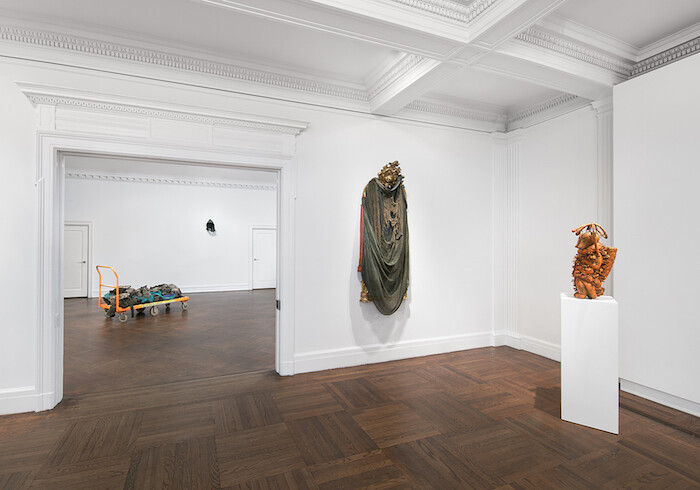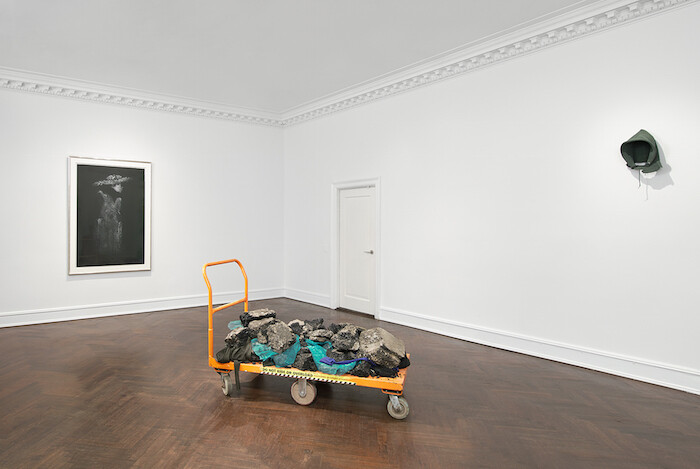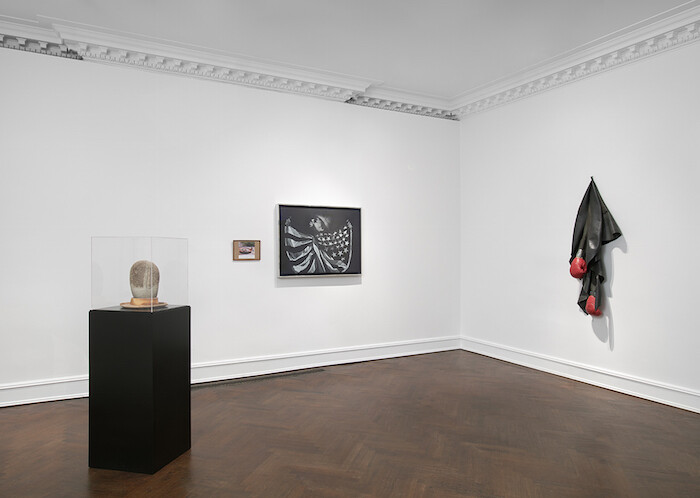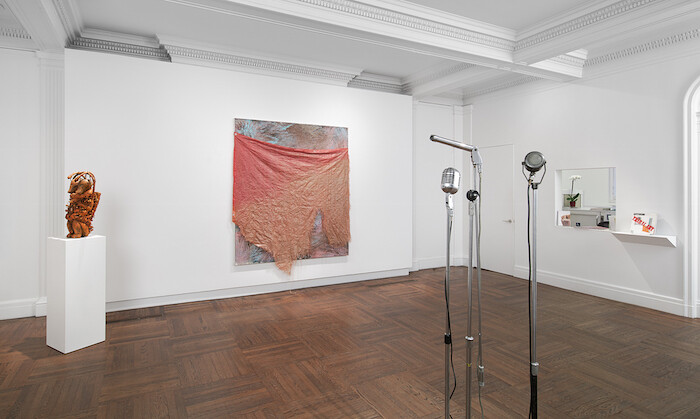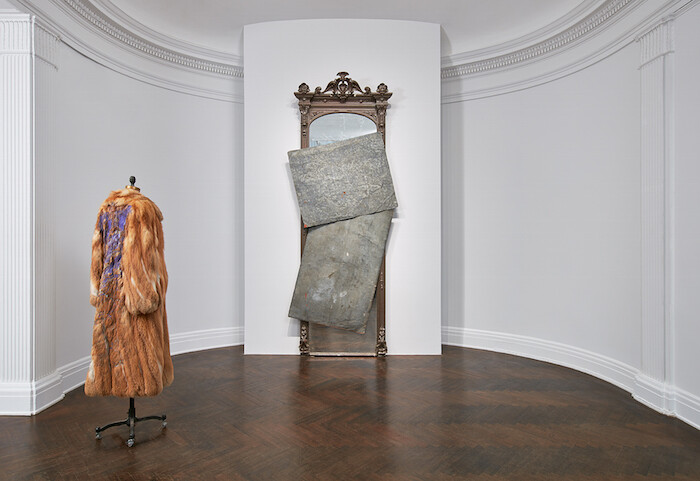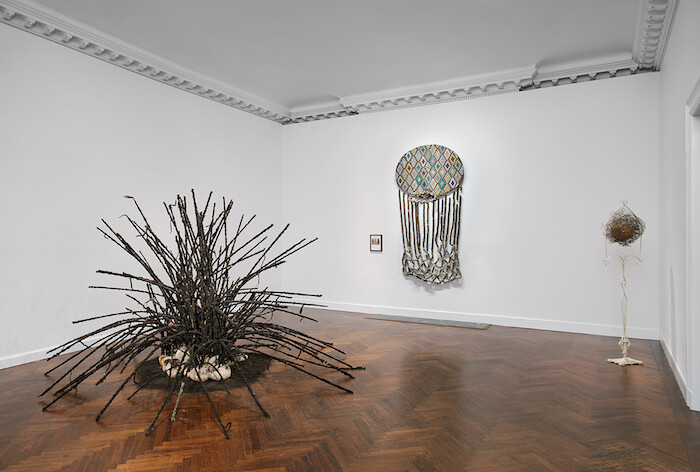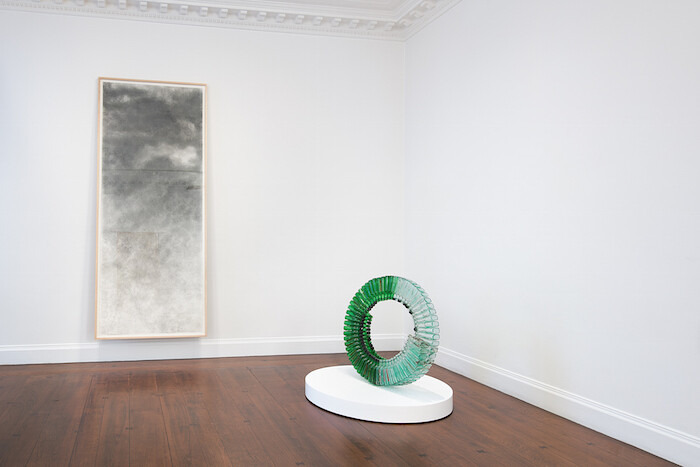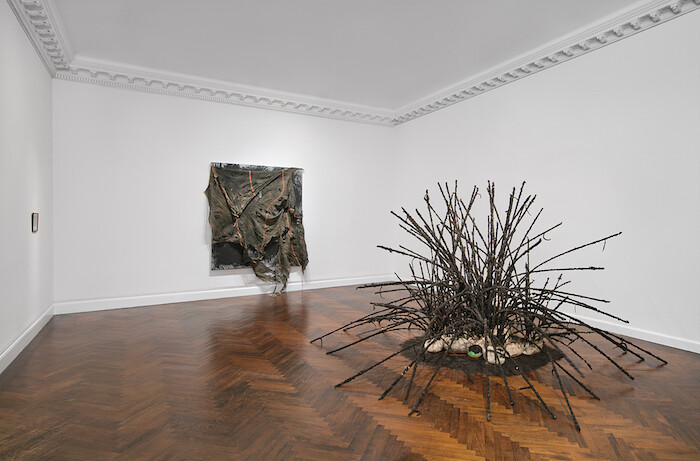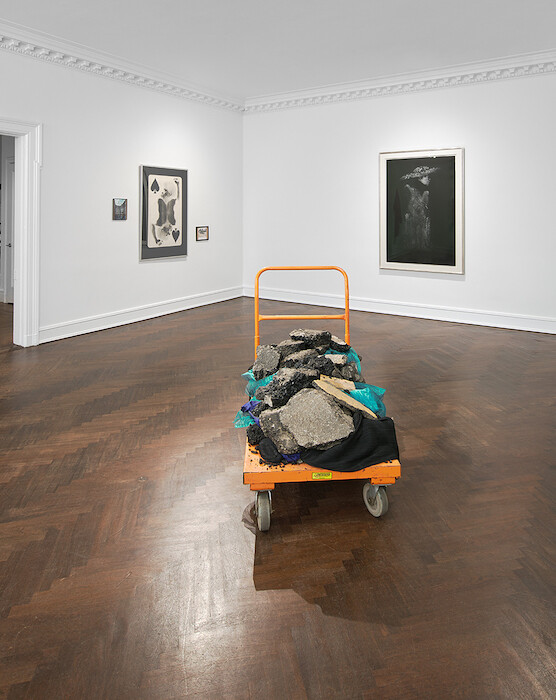Among the many brilliant and confounding works in David Hammons’s current retrospective is one entitled A Movable Object/A Japanese Garden (2012). The piece centers around a wheeled flatbed dolly, a perfectly banal machine bearing strange cargo: chunks of broken asphalt interspersed with unrecognizable articles of clothing and lengths of colorful tulle. Facing this apparent enigma, the mind grasps after established meanings. It registers familiar qualities like texture, color, and density. It tries to establish contrasts between the jagged opacity of the asphalt and the smooth translucency of the fabric. It asks questions: what is being said here about color, about blackness, about materiality or meaning?
Searching for cues, the viewer’s eye finds a warning sticker on the dolly’s side: DO NOT RIDE OR OVERLOAD. In an elliptical manner that is typical of Hammons, this caption reads as a wry, sardonic joke. Of course the “movable object” can’t be ridden, it’s an artwork. And not only is the dolly loaded with hundreds of pounds of asphalt; the sculpture seems to be overloaded with potential meanings, not all of which resolve or align. There’s a gnomic levity to this humor but also an air of faintly hostile warning: the joke’s on the person who doesn’t get the piece, or the one who makes too much of it.
For those unfamiliar with Hammons’s work, A Movable Object encapsulates the singular aesthetic of this irreplaceable artist, which stages unexpected encounters between elegance and abjection, poise and brutality, mocking laughter and dead seriousness. Recombining objects with complex affiliations to race, class, and the lived spaces of the American city, Hammons exacerbates frictions between their obdurate materiality and their function as signifiers. The resultant effect resembles what Fred Moten and Stefano Harney, in a text on black aesthetics, term “a dialectic of luxuriant withholding”: an intricate, unstable interplay between a proliferation of possible meanings and the refusal to signify as expected.1
Withholding has of course long been a part of Hammons’s public persona; the artist shuns interviews, rarely appears in public, and produces relatively little. This controlled scarcity has not only boosted the artist’s reputation, but has also inflated the value of his work, stoking the desire of collectors who jostle for position on his dealers’ waiting lists. Partly because Hammons lets his art speak for itself—but also because it has received inexplicably little serious study—it has been subject to certain misconceptions, like the idea that the artist positions himself as a trickster figure like those of West African folklore.2 Such readings, even if well intentioned, are too easily complicit with a racialized neo-primitivism—a problem that Hammons has countered by détourning masks and power figures, and by adorning the cover of Artforum with the slogan “TRIBAL ART.”
By assembling many of Hammons’s sculptures, prints, and paintings, the exhibition offers a valuable opportunity to complicate these received views. Whether it constitutes a satisfactory retrospective is up for debate. Despite the breadth of the selection, even a spacious gallery like Mnuchin can’t offer the comprehensive sweep that a major museum can—but hasn’t, and should, and soon. There’s also the fact that Hammons insisted on rehanging the show shortly before it opened, removing multiple works and inserting ten cheaply framed photos of on-site installations dating back to the early 1980s. (This gesture nodded toward the curatorial agency Triple Candie, which cleverly organized an unauthorized Hammons retrospective, composed entirely of photocopies of existing reproductions and documentation, in its Harlem exhibition space in 2006.)
These images highlight a crucial dimension of Hammons’s production, one which the exhibition otherwise largely ignores: his execution of sculptural interventions and guerrilla performances during the decades of New York City’s transformation from a deindustrializing dystopia to a neoliberal showcase. As signaled in his two pivotal engagements with Richard Serra’s sculpture T.W.U. (1980–81)—in Shoe Tree (1981) Hammons tossed pairs of sneakers over its top, while in Pissed Off (1981) he urinated against its side—Hammons amplified the critical potential of site-specificity while deflating its monumental aspirations. In subsequent pieces like the justly celebrated Bliz-aard Ball Sale (1983), but also the equally strong Delta Spirit House (1985), Higher Goals (1986), and Four Beats to the Bar (1990), he confronts non-art audiences with sharp but cryptic references toward gentrification, financialization, and the gendered racialization of urban space.
Throughout such work, as in his oeuvre more generally, Hammons has consistently rearticulated the relation between race, sense, and materiality. In Spade (Power for the Spade) (1969), a print made by applying margarine to his own person, he uses the black body simultaneously as material, instrument, signifier, and subject. As the self-contradictory title suggests, the piece collides starkly opposed signs; in one image we see the Afro and raised fist of Black Power and the prominent nose and lips of racist caricature. Instead of cancelling each other out, these markers portray blackness as a kind of double bind, in which any attempt to resignify racial identity is inevitably also determined by its structural, symbolic, and extra-subjective status. One can’t unilaterally seize or speak the truth of blackness, but neither can one deny it, especially as it governs vulnerability to different modes of violence.
This complex, nuanced position informs Hammons’s persistent use of racialized materials like black hair, “Harlem earth,” fried chicken, and dark pigment. While such a stance made him an outlier during the 1970s at the peak of the comparatively essentialist Black Arts Movement, it makes him look unbelievably prescient from a more recent perspective, when figures like Thelma Golden and Darby English have called for a non-identitarian aesthetic that decouples black artists from restrictive expectations. A similarly prophetic force is evident in the 1993 sculpture In the Hood, which uses a slashed hoodie as a disembodied portrait of ghettoized black masculinity, and which was taken up as a popular avatar for Black Lives Matter activists in the wake of Trayvon Martin’s murder. It testifies to the power and complexity of such work that it can function effectively as a thumbnail-sized denunciation of racist state violence, and moreover that it can do so without losing its aesthetic and conceptual impact.
Overall, the Mnuchin show succeeds primarily in reminding us that much more remains to be thought and said about Hammons. We need to know more about his engagement with Japanese culture, which is alluded to but not elaborated. Closer attention should be paid to the way he interleaves race with masculinity and with class, as in Champ (1989), which splices together references to Muhammad Ali, menial labor, and detumescence. And little has been said about Hammons’s recent turn from “poor” materials like Night Train wine bottles to “rich” ones like fur coats, or about how these are combined in his tarp paintings, which layer construction netting over large abstractions.
Such gestures read somewhat awkwardly in a posh blue-chip gallery on the Upper East Side. Even as Hammons skewers the privilege and market-dictated tastes of a wealthy, presumably largely white audience, he also indulges them, as if trying to have it both ways. It is more encouraging to learn, as was recently announced, that Hammons has purchased a building in the nearby city of Yonkers with the intention of turning it into a gallery. Nothing is known yet about his plans. This is of course not surprising; it is also fitting, and tantalizing, and a reminder to keep paying close attention to him.
Fred Moten and Stefano Harney, The Undercommons: Fugitive Planning and Black Study (New York: Minor Compositions, 2013), 48.
See for example Courtney Willis Blair, “Trickster Aesthetics,” Modern Painters (April 2016): 63-65.
